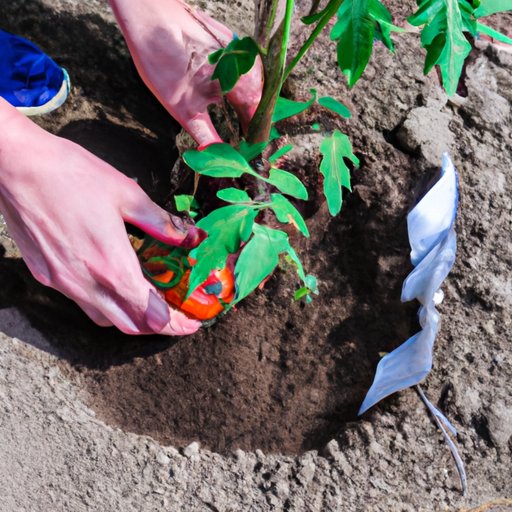Introduction
Tomatoes are one of the most widely-grown vegetables in the world, and they’re also a favorite among home gardeners. But knowing when to plant tomatoes can be tricky. The ideal planting time depends on a variety of factors, from climate data to soil conditions to local agricultural practices. This article will explore these factors in detail to help you determine the best time to plant tomatoes in your area.
Analyzing Climate Data to Determine the Best Time to Plant Tomatoes
One of the most important considerations when planting tomatoes is the temperature. Tomatoes need warm weather for optimal growth, with temperatures ideally between 70-85°F (21-29°C) during the day and 60-70°F (15-21°C) at night. If temperatures drop below 50°F (10°C), tomato plants may suffer damage or even die. You should also take into account other weather conditions such as humidity, rainfall, and sunlight.

Examining Different Varieties of Tomatoes to Decide When to Plant
Different varieties of tomatoes have different climate needs. Some are more heat-tolerant than others, while some require cooler temperatures. Determining the right variety for your location is key to successful tomato planting. Heirloom tomatoes, for instance, tend to thrive in cooler climates, while cherry tomatoes do better in warmer climates. Researching each variety’s specific needs is essential for choosing the best time to plant tomatoes.

Exploring Soil Conditions and Nutrients Needed for Tomato Planting
The type of soil you use for planting tomatoes is also important. The soil should be well-draining and fertile, with a pH level of 6.0-7.0. If the pH level is too high or low, the tomatoes may not grow properly. Additionally, adding organic matter such as compost or manure will provide the necessary nutrients for healthy tomato growth. You should also consider if the soil has been treated with any chemicals such as pesticides or herbicides, which could affect plant health.
Making Use of Plant Hardiness Zones to Choose the Right Planting Time
Plant hardiness zones are geographic areas that share similar climatic conditions. Knowing your zone can help you determine the best time to plant tomatoes. Each zone is divided into two sections, indicating the coldest and warmest temperatures that plants can tolerate. You can find your zone by looking up your zip code on the USDA Plant Hardiness Zone Map. Once you know your zone, you can plan accordingly and choose the best time to plant tomatoes.

Utilizing Companion Planting Principles to Maximize Tomato Yields
Companion planting is an age-old gardening technique that uses plants to benefit one another. When planted together, certain plants can increase the yields of their companions, improve pest control, and even enhance flavor. For example, planting basil near tomatoes can help repel aphids and attract pollinators, resulting in bigger and tastier tomatoes. Utilizing companion planting principles when planting tomatoes can help maximize yields and produce better crops.
Comparing Different Growing Methods to Find the Best Time to Plant Tomatoes
There are several different growing methods for tomatoes, including hydroponic and traditional gardening, container gardening, and in-ground gardening. Each method has its own advantages and disadvantages, so it’s important to research them all before deciding which is best for you. In general, hydroponics is great for year-round growing, while traditional gardening and in-ground gardening are better suited for seasonal planting. Container gardening is ideal for those with limited space.

Researching Local Agricultural Practices to Optimize Tomato Planting Timing
Finally, it’s important to research local agricultural practices when determining the best time to plant tomatoes. Local farmers often have knowledge of traditional planting methods that work best in their area. They can provide valuable insight into the best times to start seeds, when to transplant seedlings, and when to expect the first harvest. Learning from local farmers can help you optimize your tomato planting timing.
Conclusion
Choosing the best time to plant tomatoes requires careful consideration of a variety of factors. Analyzing climate data, examining different varieties of tomatoes, exploring soil conditions and nutrients needed, making use of plant hardiness zones, utilizing companion planting principles, comparing different growing methods, and researching local agricultural practices are all important steps in ensuring a successful tomato crop. By following the advice in this article, you’ll be able to determine the best time to plant tomatoes in your area.


